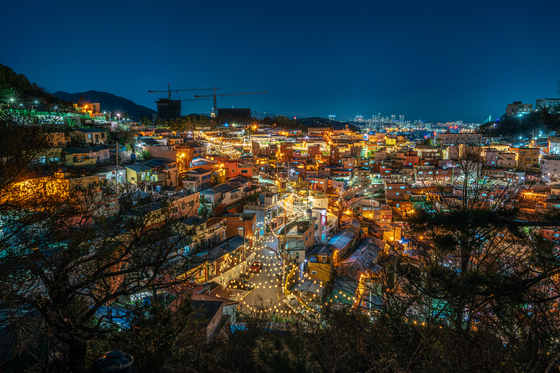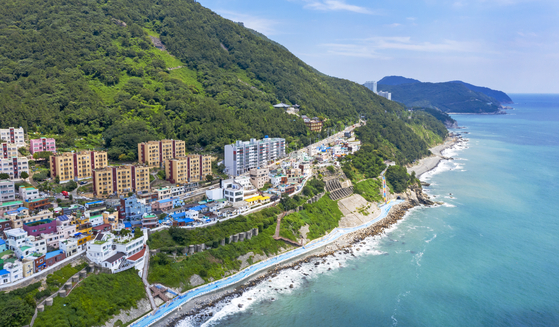Coffee and art line the streets of Korea's biggest port city

![The Gamcheon Culture Village in Saha District [VISIT BUSAN]](https://koreajoongangdaily.joins.com/data/photo/2023/04/06/da434146-04b1-45a7-98da-9eec0a935f52.jpg)
The Gamcheon Culture Village in Saha District [VISIT BUSAN]
Along the beautiful Dalmaji Road coastline within walking distance of Busan’s Haeundae Beach is an array of Instagram-friendly cafes that offer a great view of the crystal-clear seascape of the southern port city.
It’s no surprise that Busan is famous for its beaches and traditional marketplaces, but many may be unaware of the fact that it is also a city famous for its coffee. According to Statistics Korea, there were 6,653 cafes in the entire city of Busan as of 2020, and in Haeundae District alone, where the famous Dalmaji Road is situated, there are 684, accounting for about 10 percent.
Dalmaji Road, the name of which translates to “greeting the moon,” offers a stunning night view of the moonlit cherry blossom trees overlooking the sea and is a must-visit especially during the warm spring and summer months. A typical scene on the weekends would involve cars lined up on the road and the sidewalks and cafes packed with people taking like-worthy pictures.
Because the cafes are so popular and it’s difficult to find a seat during the busy months, it’s normal for the cafes to be open until 10 p.m. at night, still brightly lit and bustling inside.
On Instagram, there are over 135,000 posts under the Korean hashtags #DalmajiCafe and #DalmajiRoadCafe. Almost every post tagged shows mouthwatering brunch dishes or a spectacular sunset, proving that Busan is a city more than suitable to kick back and relax.
Korea is a huge coffee importer. It was estimated that Korea’s coffee market took up roughly 11 trillion won ($8.4 billion) as of 2020. One of the reasons that Busan became a mecca for coffee can be attributed to how about 95 percent of all coffee imports come through the Busan Port, according to the Busan Ilbo newspaper.
Another feature worth noting is that these cafes are not the average big name franchises. They often have distinctive styles that tend to attract certain visitors. For instance, the P.Ark cafe in Yeongdo District, which opened in 2015, is Korea’s largest coffee shop and bustles with people both on weekdays and weekends.
![The Huinnyeoul Culture Village in Yeongdo District [VISIT BUSAN]](https://koreajoongangdaily.joins.com/data/photo/2023/04/06/f67969da-c474-46af-9811-584045777b32.jpg)
The Huinnyeoul Culture Village in Yeongdo District [VISIT BUSAN]
Busan is also home to three baristas adorned with titles from global coffee competitions: Jeon Joo-yeon of Momos Coffee Busan for the 2019 World Barista Championships, Chu Kyoung-ha of Momos again for the 2021 World Cup Tasters Championship and Moon Heon-gwan of Month Coffee for the same competition in 2022. Adding to the expertise, it’s no wonder that the city highly touts the caffeinated bean drink.
Such specialty cafes are easily seen in other major sightseeing spots, especially the Gamcheon Culture Village in Saha District and Huinnyeoul Culture Village in Yeongdo District.
Though Gamcheon Culture Village is often brought up as one of the most desired locations to visit while traveling in Busan for its beautiful, colorful clusters of homes, its history is not quite so cheerful, as it was an area that was once home to war refugees during the 1950-53 Korean War.
In an attempt to add brightness and color to the neighborhood that once had to bear Korea’s sad history, local artists contributed their talent to make art for the village in 2009 — one of the most famous ones being the statues depicting Antoine de Saint-Exupéry’s prince and fox from "The Little Prince," made by artist Na In-ju. Taking a picture sitting between these two sculptures has become one of the city's best photo op spots that almost always has a line of people waiting their turn.
While Gamcheon is on top of a mountain, the peaceful Huinnyeoul Culture Village — think, a Korean version of Greece's Santorini cliffs — sits along a seashore cliff on the small island of Yeongdo, which is connected to the mainland by Yeongdo Bridge, also the first movable bridge in Busan.

![The Huinnyeoul Culture Village in Yeongdo District [VISIT BUSAN]](https://koreajoongangdaily.joins.com/data/photo/2023/04/06/1e1965aa-16e5-48f9-b967-15271c60c4d0.jpg)
The Huinnyeoul Culture Village in Yeongdo District [VISIT BUSAN]
“Busan is indeed a magnificent city to enjoy Korea’s diverse culture — its food, drinks and nature,” said Grace Lim, a traveler from Australia. “I just couldn’t stop taking pictures of the beautiful scenery, the street food and all different kinds of fish at the fish market, and of course the beautiful cafes I stopped by every single day. I don’t speak a word of Korean, but it was so easy to navigate and the people were so friendly that I really hope to come back with my family next time.”
BY SHIN MIN-HEE, YIM SEUNG-HYE [yim.seunghye@joongang.co.kr]










with the Korea JoongAng Daily
To write comments, please log in to one of the accounts.
Standards Board Policy (0/250자)